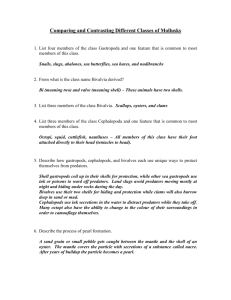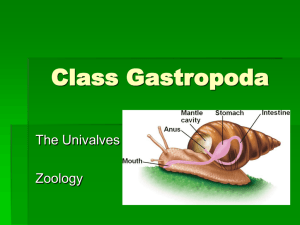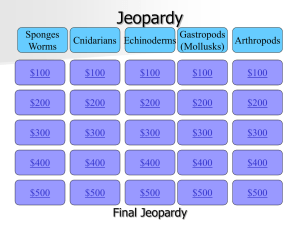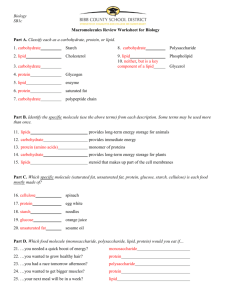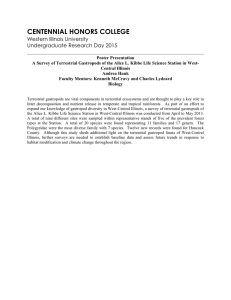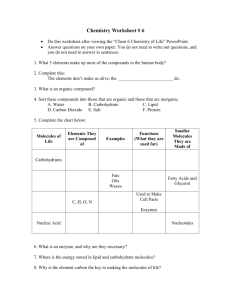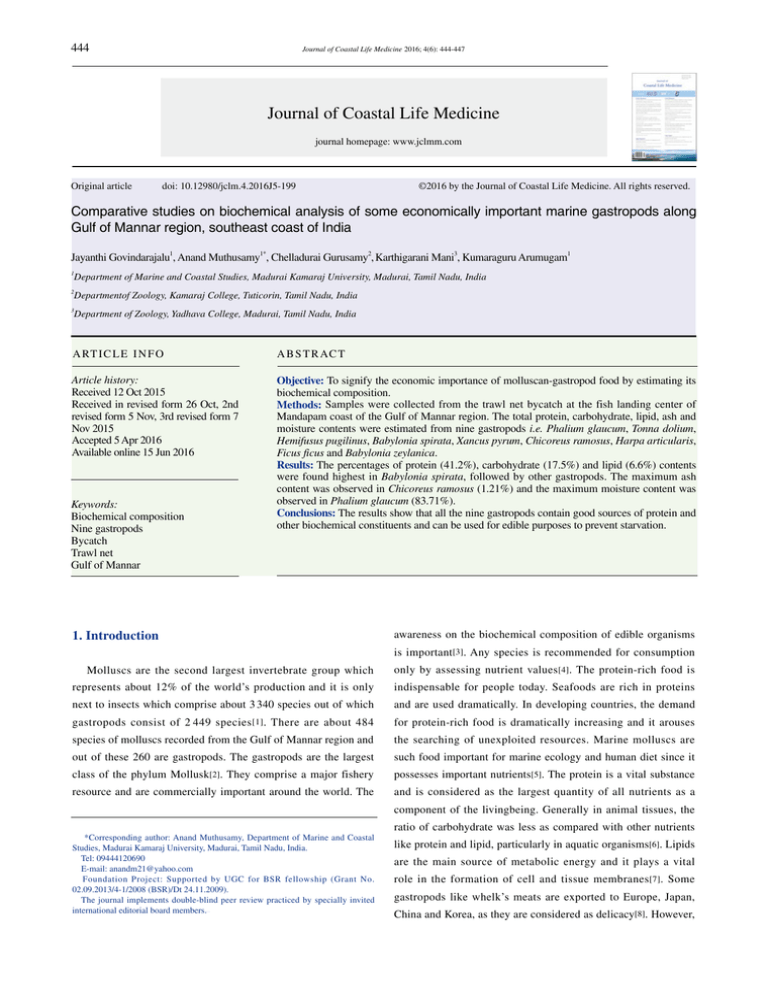
444
Journal of Coastal Life Medicine 2016; 4(6): 444-447
Journal of Coastal Life Medicine
journal homepage: www.jclmm.com
Original article
doi: 10.12980/jclm.4.2016J5-199
©2016 by the Journal of Coastal Life Medicine. All rights reserved.
Comparative studies on biochemical analysis of some economically important marine gastropods along
Gulf of Mannar region, southeast coast of India
Jayanthi Govindarajalu1, Anand Muthusamy1*, Chelladurai Gurusamy2, Karthigarani Mani3, Kumaraguru Arumugam1
1
Department of Marine and Coastal Studies, Madurai Kamaraj University, Madurai, Tamil Nadu, India
2
Departmentof Zoology, Kamaraj College, Tuticorin, Tamil Nadu, India
3
Department of Zoology, Yadhava College, Madurai, Tamil Nadu, India
A RT I C L E I N F O
A B S T R AC T
Article history:
Received 12 Oct 2015
Received in revised form 26 Oct, 2nd
revised form 5 Nov, 3rd revised form 7
Nov 2015
Accepted 5 Apr 2016
Available online 15 Jun 2016
Objective: To signify the economic importance of molluscan-gastropod food by estimating its
biochemical composition.
Methods: Samples were collected from the trawl net bycatch at the fish landing center of
Mandapam coast of the Gulf of Mannar region. The total protein, carbohydrate, lipid, ash and
moisture contents were estimated from nine gastropods i.e. Phalium glaucum, Tonna dolium,
Hemifusus pugilinus, Babylonia spirata, Xancus pyrum, Chicoreus ramosus, Harpa articularis,
Ficus ficus and Babylonia zeylanica.
Results: The percentages of protein (41.2%), carbohydrate (17.5%) and lipid (6.6%) contents
were found highest in Babylonia spirata, followed by other gastropods. The maximum ash
content was observed in Chicoreus ramosus (1.21%) and the maximum moisture content was
observed in Phalium glaucum (83.71%).
Conclusions: The results show that all the nine gastropods contain good sources of protein and
other biochemical constituents and can be used for edible purposes to prevent starvation.
Keywords:
Biochemical composition
Nine gastropods
Bycatch
Trawl net
Gulf of Mannar
1. Introduction
awareness on the biochemical composition of edible organisms
is important[3]. Any species is recommended for consumption
Molluscs are the second largest invertebrate group which
only by assessing nutrient values [4]. The protein-rich food is
represents about 12% of the world’s production and it is only
indispensable for people today. Seafoods are rich in proteins
next to insects which comprise about 3 340 species out of which
and are used dramatically. In developing countries, the demand
gastropods consist of 2 449 species [1] . There are about 484
for protein-rich food is dramatically increasing and it arouses
species of molluscs recorded from the Gulf of Mannar region and
the searching of unexploited resources. Marine molluscs are
out of these 260 are gastropods. The gastropods are the largest
such food important for marine ecology and human diet since it
class of the phylum Mollusk[2]. They comprise a major fishery
possesses important nutrients[5]. The protein is a vital substance
resource and are commercially important around the world. The
and is considered as the largest quantity of all nutrients as a
component of the livingbeing. Generally in animal tissues, the
ratio of carbohydrate was less as compared with other nutrients
*Corresponding author: Anand Muthusamy, Department of Marine and Coastal
Studies, Madurai Kamaraj University, Madurai, Tamil Nadu, India.
Tel: 09444120690
E-mail: anandm21@yahoo.com
Foundation Project: Supported by UGC for BSR fellowship (Grant No.
02.09.2013/4-1/2008 (BSR)/Dt 24.11.2009).
The journal implements double-blind peer review practiced by specially invited
international editorial board members.
like protein and lipid, particularly in aquatic organisms[6]. Lipids
are the main source of metabolic energy and it plays a vital
role in the formation of cell and tissue membranes [7]. Some
gastropods like whelk’s meats are exported to Europe, Japan,
China and Korea, as they are considered as delicacy[8]. However,
Govindarajalu Jayanthi et al./Journal of Coastal Life Medicine 2016; 4(6): 444-447
445
some are not utilized even though they have high proteins. Since
lipid, ash and moisture contents. They were commonly found in
in the past whelks such as Babylonia spirata (B. spirata), sacred
the Mandapam coast of Gulf of Mannar region.
chank, i.e. Xancus pyrum (X. pyrum), limpets and trochids were
used for edible purposes by poor people in the coastal areas of
3.1. Percentage of total protein
Gulf of Mannar region when fish is not available. Though some
species of gastropods are consumed throughout the Mandapam
Protein is the indispensable component of life desired for the
coast as food by local fishermen, many species are remaining
existence and it was expressed in percentage from the following
unexploited and the resources of gastropods should be utilized
organisms B. spirata (41.2%), B. zeylanica (40.8%), H. pugilinus
to prevent the global communities from malnutrition. So the
(38.9%), C. ramosus (37.3%), X. pyrum (37.2%), H. articularis
present study intends to analyze the biochemical content of nine
(35.2%), P. glaucum (35.1%), T. dolium (33.6%), F. ficus (31.2%).
gastropods from the Gulf of Mannar region, southeast coast of
Maximum protein content was observed in B. spirata and the
India.
minimum was observed in F. ficus.
2. Materials and methods
3.2. Percentage of total carbohydrate
The carbohydrate contents were estimated for the nine
2.1. Sampling and preprocessing
gastropods and the values were found as B. spirata (17.5%), H.
Gastropods were collected from trawl net bycatch at the fish
pugilinus (16.9%), B. zeylanica (16.6%), C. ramosus (15.2%), X.
landing center of Mandapam coast of the Gulf of Mannar region.
pyrum (14.5%), H. articularis (14.3%), P. glaucum (14.2%), F.
The organisms were identified by standard keys provided by
ficus (13.5%) and T. dolium (12.3%). The maximum carbohydrate
Adoni [9] and were washed to remove impurities and dusts by
content was observed in B. spirata and the minimum was observed
using distilled water and the outer shells were carefully removed
in T. dolium.
and dissected out and dried in hot air oven at 40
°C
for 48 h. The
dried material was powdered, sieved and used for further analysis
3.3. Percentage of total lipid
in triplicate to analyze the total protein, carbohydrate, lipid, ash
and moisture contents.
Lipids are major sources of metabolic energy and essential
compounds for the formation of cell and tissue membranes. The
lipid contents were estimated and the values were found as B.
2.2. Estimation of biochemical parameters
spirata (6.6%), B. zeylanica (6.1%), H. articularis (4.7%), X.
The protein contents in the body tissues of gastropods
pyrum (4.3%), P. glaucum (3.9%), F. ficus (2.2%), C. ramosus
method [10] .
(2.0%), T. dolium (1.9%) and H. pugilinus (1.1%). The maximum
The carbohydrate content was estimated using the procedure
lipid content was observed in B. spirata and the minimum was
of phenol-sulfuric acid method [11] . The lipid was estimated
observed in H. pugilinus.
were estimated by the Folin-Ciocalteu phenol
using chloroform-methanol mixture [12] . The water content
was estimated by subtracting the dry weight from the known
3.4. Percentage of total ash
wet weight of the sample [13] . Ash content was estimated by
powdering 1 g of tissue in porcelain crucible and kept in a muffle
furnace at 60 °C for 4 h and weighed[14].
The ash content was estimated and expressed in percentage
and the values were found as C. ramosus (1.20%), B. zeylanica
(1.19%), H. pugilinus (1.10%), P. glaucum (0.98%), F. ficus
3. Results
(0.93%), X. pyrum (0.88%), B. spirata (0.85%), T. dolium (0.82%)
and H. articularis (0.81%). The maximum ash content was
The studies about biochemical composition of the seafood
organisms are necessary to prevent malnutrition problems. In the
observed in C. ramosus and the minimum amount was observed in
H. articularis.
present study, nine economically important marine gastropods,
namely, Phalium glaucum (P. glaucum), Tonna dolium (T.
3.5. Percentage of total moisture
dolium), Hemifusus pugilinus (H. pugilinus), B. spirata, X.
pyrum, Chicoreus ramosus (C. ramosus), Harpa articularis (H.
The moisture content was observed in the nine gastropods and
articularis), Ficus ficus (F. ficus) and Babylonia zeylonica (B.
the obtained values were P. glaucum (83.7%), X. pyrum (81.2%),
zeylanica), were used for the estimation of protein, carbohydrate,
B. spirata (80.0%), B. zeylonica (78.1%), H. articularis (72.0%),
446
Govindarajalu Jayanthi et al./Journal of Coastal Life Medicine 2016; 4(6): 444-447
H. pugilinus (71.3%), F. ficus (67.1%), C. ramosus (65.4%) and T.
species of the same genus or between sexes[25]. Giese observed that
dolium (60.15%). The maximum moisture content was observed in
the moisture content of Unio terminalis was 80.36% and Patomida
P. glaucum and the minimum was observed in T. dolium.
littoralis was 81.69% [17]. In the present study, the maximum
moisture content was observed in P. glaucum (83.7%) followed by
4. Discussion
other gastropods. Margret et al.[14] observed that the ash content
of gastropods was very less which is about 1.18% in B. zeylonica
Seafoods are important constituents of the human diet.
followed by other gastropods. In our present study, the maximum
Nowadays, the protein deficiency increases in developing
ash content was observed in C. ramosus (1.20%). From the result,
countries. It has stimulated the exploration of non-traditional
B. spirata showed the maximum values of protein, carbohydrate
resources[15]. The utilisation of edible gastropods is limited and
and lipid when compared with other gastropods, which differed
restricted to poor coastal people, though snail meat is delicious and
from the previous study by Margret [14] who showed that the
nutrient. The limited utilization is mainly due to the conservative
nutritive value of B. zeylonica was more when compared with other
food habits of mankind and the lack of knowledge about the
gastropods. According to Khalua et al.[26], protein, carbohydrate
nutritive value of the mollusks, particularly gastropods[16]. The
and lipid were the maximum during pre-monsoon period than
analysis of biochemical constituents in organisms was useful in
monsoon and post-monsoon periods. So, further studies are needed
grading their consumption as food. It could be told from this study
to know the variation during monsoon period. Many mollusks
that all the nine gastropods possessed good quantity of protein,
have been considered as edible food according to Srilatha et al.[27],
carbohydrate, lipid, ash and moisture. Among the constituents,
and the study clearly indicates that Meretrix casta is an important
protein was found to be highest followed by carbohydrate and
part of a balanced diet and contributes to a good nutritional status.
lipid. The values of protein of the present study ranged from
Subavathy et al.[28] reported the preparation of soup, curry and
31.2% to 41.2%. Giese[17] found that mollusks’ protein was the
cutlet from the foot and mantle of Fusinus nicobaricus provides
dominant organic constituent in the whole body composition and
the way to use marine resources. According to Anand et al.[29],
it was evidently consistent with the present study. According to
P. trapezium meat acts as the food source that can be utilized like
Kunusaki[18], the protein content varies from animal to animal and
other seafoods. Several studies reported that marine mollusks
in our present study all the nine gastropods show variations in the
reserve biochemical energy in the reproductive or somatic tissue
protein contents and other biochemical constituents. Nirmal[19]
for use when needed[30]. The malnutrition problem in our country
observed the highest value of protein content (68.31%) in body
can be overcome by effective utilization of nutrient-rich mollusc
tissue of male B. zeylonica whereas in female samples (69.75%).
seafoods. In India, 20%–30% of the population does not get
According to Kamalkanth et al.[20], the percentage of protein in the
adequate nutrition. Proper exploitation of aquatic through capture
tissue of Thais mutabilis was 53.86% and its meat was valuable
and culture fisheries will supply the balanced nutritious food and
studied the proximate
malnutrition can be controlled. A balanced diet should provide
composition of H. pugilinus and revealed that protein and lipid
around 60%–70% of total calories from carbohydrates, preferable
contents were high. Hence, H. pugilinus was the potential source
starch, about 10%–12% from protein and 20%–25% from fat.
food with high quality of protein.
Sekar[21]
for nutritive value and it is strongly recommended for human
consumption.
Since ancient times, the finfish and shellfish have been important
sources of animal proteins for mankind all over the world. So the
The carbohydrate of the present study ranged from 12.3% to
food source should be properly used for the well being of people.
17.5%. The result was high when compared with the previous
In the present study, all the nine gastropods possess high values
study reported by Suryanarayanan and Nair[22] analyzed in Turbo
of protein and other biochemical constituents and hence they are
bruneus (1.1%–9.2% in males and 1.5%–9.2% in females). Babu et
recommended for human consumption to prevent starvation.
al.[6] reported that the carbohydrate level was 3.4%–7.7% in Bursa
spinosa. Geise[17] observed that lipid acts as a reserve material and
Conflict of interest statement
is utilized during stress situation. Ansari[23] reported that the lipids
have little role throughout the seasonal cycle. In Turbo brunneus,
We declare that we have no conflict of interest.
the lipid value is higher in ovary with a maximum value of 4.85%
and in testis 4.20%. According to McLachlan and Lombard[24], the
Acknowledgments
lipid values ranged from 3.90% to 7.40% in various size groups
of Turbo sarmaticus. In the present study, the lipid values ranged
We thank UGC for BSR fellowship for financial support (Grant
from 1.1% to 6.6%. The gastropods had higher water content than
No. 02.09.2013/4-1/2008 (BSR)/Dt 24.11.2009) and DST PURSE
the bivalves and the variation was not significant between the
for the consumable support for completing the study.
Govindarajalu Jayanthi et al./Journal of Coastal Life Medicine 2016; 4(6): 444-447
References
447
Cymbium melo (Solander, 1786). Indian J Fish 2010; 57(3): 35-9.
[17] Giese AC. A new approach to the biochemical composition of the
[1] FAO. Fishery Software. FISHSTAT Plus. Universal software for
mollusc body. Oceanogr Mar Biol Ann Rev 1969; 7: 175-229.
fishery statistical time series. Rome: FAO. [Online] Available from:
[18] K unusaki N. Nutritional properties of squid and cuttlefish. In:
http://www.grida.no/geo/GEO/Geo-2-237.htm [Accessed on 9th
Okuzumi M, Fujii T, editors. Nutritional and functional properties
October, 2015]
of squid and cuttlefish. Tokyo: National Cooperative Association of
[2] B
runt J, Engel Berger K, Rapp G. Giant African snail plant protection
service. Fiji: Secretariat of the Pacific Community; 1999, p. 4.
[3] N
agabhushanam R, Mane VH. Seasonal variation in the biochemical
composition of Mytilus viridis at Ratnagiri on the West Coast of India.
Hydrobiologia 1978; 57(1): 69-72.
Squid Processors; 2000.
[19] N irmal A. Biochemical studies on prosobranchian gastropods
Babylonia zeylonica (Neogastropods: Buccinidae: Fasciolariidae)
[dissertation]. Annamalai Nagar: Annamalai University; 1995, p. 30.
[20] K amalkanth S, Ponni AC, Muniyan M, Chandravathani S.
[4] Xavier RM. Studies on the biochemistry and processing of edible
Biochemical composition of intertidal muricid gastropod Thais
meat of muricid gastropods Chicoreus virgineus (Roding, 1798) and
mutabilis (Link) in Tranquebar, Nagapattinam District, southeast
Rapana rapiformis (Born, 1778) [dissertation]. Annamalai Nagar:
Annamalai University; 1996.
[5] A jayabhaskar D. Nutritional evalution of molluscan sea food
[dissertation]. Annamalai Nagar: Annamalai University; 2002.
[6] Babu A, Kesavan K, Annadurai D, Rajagopal S. Bursa spinosa - a
mesogastropod fit for human consumption. Adv J Food Sci Technol
2010; 2(1): 79-83.
[7] Sargent JR. Origins and function of lopids in fish eggs: nutritional
coast of Tamilnadu India. Int J Mod Res Rev 2014; 2(1): 8-14.
[21] Sekar V, Ravi V, Dhinakaran A, Rajasekaran R, Elaiyaraja C. Nutritive
profiles in different size groups and body parts of common whelk
Hemifuses pugilinus (born, 1778) from Pazhayar, southeast coast of
India. Online J Anim Feed Res 2012; 2(2): 189-96.
[22] Suryanarayanan H, Nair NB. Seasonal variation on the biochemical
constitutes of Cellana radiata (Born). Indian J Mar Sci 1976; 51:
125-8.
implications. In: Bromage NR, Roberts RJ, edtors. Broodstock
[23] Ansari ZA, Parulekar AH, Motondkar SGP. Seasonal changes in meat
management and egg and larval activity. Oxford: Blackwell Sciences;
weight and biochemical composition in the black clam, Villorita
1995, p. 353-72.
cyprinoides (Grey). Indian J Mar Sci 1981; 10: 128-31.
[8] Ramón M, Amor MJ. Reproductive cycle of Bolinus brandaris and
[24] M cLachlan A, Lombard HW. Seasonal variations in energy and
penis and genital duct size variations in a population affected by
biochemical components of an edible gastropod, Turbo sarmaticus
imposex. J Mar Biol Assoc UK 2002; 82(3): 435-42.
[9] Adoni AD. Workbook on limnology. Sagar: Pratibha Publishers; 1985,
p. 216.
(Turbinidae). Aquaculture 1980; 19(2): 117-25.
[25] M ohammad SH. Water content as a new tool for discrimination
between some shellfishes. Pak J Biol Sci 2015; 18: 204-14.
[10] L owry OH, Rosebrough NJ, Farr AL, Randall RJ. Protein
[26] K halua RK, Tripathy S, Paul B, Bairy D. Seasonal variation of
measurement with the Folin phenol reagent. J Biol Chem 1951;
carbohydrate, protein and lipid of common freshwater edible
193(1): 265-75.
gastropod (Bellamya bengalensis) of Medinipur District, West
[11] DuBois M, Giles KA, Hamilton JK, Rebors PA, Smith F. Colorimetric
method for determination of sugars and related substances. Anal
Chem 1956; 28(3): 350-6.
Bengal. Res J Biol 2014; 2: 49-52.
[27] S rilatha G, Chamundeeswari K, Ramamoorthy K, Sankar G,
Varadharajan D. Proximate, amino acid, fatty acid and mineral
[12] F olch J, Lees M, Sloane Stanley GH. A simple method for the
analysis of clam, Meretrix casta (Chemnitz) from Cuddalore and
isolation and purification of total lipid from animal tissues. J Biol
Parangipettai coast, south east coast of India. J Mar Biol Oceanogr
Chem 1957; 226(1): 497-509.
2013; 2: 2.
[13] S hanmugam A, Bhuvaneswari T, Arumugam M, Nazeer RA,
[28] Subavathy P, Chanramathi V, Thilaga RD, Tamilselvi M. Fusinus
Sambasivam S. Tissue chemistry of Babylonia spirata (Linnaeus).
nicobaricus - an excellent neogastropod for preparation of good
Indian J Fish 2006; 53(1): 33-9.
[14] Margret MS, Santhiya M, Mary MT, Jansi M. Comparative study
recipes. Int J Pharm Biol Sci 2013; 3(1): 432-6.
[29] Anand TP, Chellaram C, Chandrika M, Rajamalar CG, Parveen AN,
on the biochemical composition of four gastropods along the
Shanthini F. Nutritional studies on marine mollusk Pleuroploca
Kanyakumari coast. World J Fish Mar Sci 2013; 5(6): 637-40.
trapezium (Gastropoda: Fasciolariidae) from Tuticorin coastal waters.
[15] Woodcock SH, Benkendorff K. The impact of diet on the growth
and proximate composition of juvenile whelks, Dicathais orbita
(Gastropoda: Mollusca). Aquaculture 2008; 276(1-4): 162-70.
[16] Palpandi C, Vairamani S, Shanmugam A. Proximate composition
and fatty acid profile of different tissues of the marine neogastropod
J Chem Pharm Res 2013; 5(4): 16-21.
[30] Çelik MY, Karayücel S, Karayucel I, Öztürk R, Eyüboğlu B. Meat
yield, condition index, and biochemical composition of mussels
(Mytilusgallo provincial in Lamark, 1819) in Sinop, south of the
Black Sea. J Aquat Food Prod Tech 2012; 21(3): 198-205.

